Many users cropped cameras often complain that it’s difficult to get a good picture from such a camera and that you must use full frame. Many people just drool on full-frame camerasthinking that they can do something improve their photos. And if you really want to shoot a full frame, and at the same time invest a little bag of money to purchase a camera, then this article is just for you.
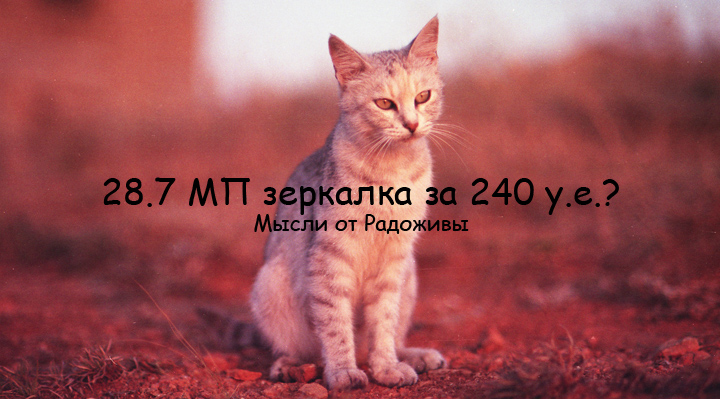
Shot on the same Full Frame :) 28 MP for 240 cu The cat is photographed in the sunset red sun.
Any good photography is based on the desire and skill of the photographer, everything else (including photographic equipment) is just a distraction from the main goal. I am often reproached for advocating to shoot with cheap equipment. I don’t actually do that, I advocate the idea that you can get a good shot from any camera if you want. Of course, the better the technique, the easier and faster the result can be achieved. Those who want to get good pictures get them from anyone, sometimes even the cheapest technique.
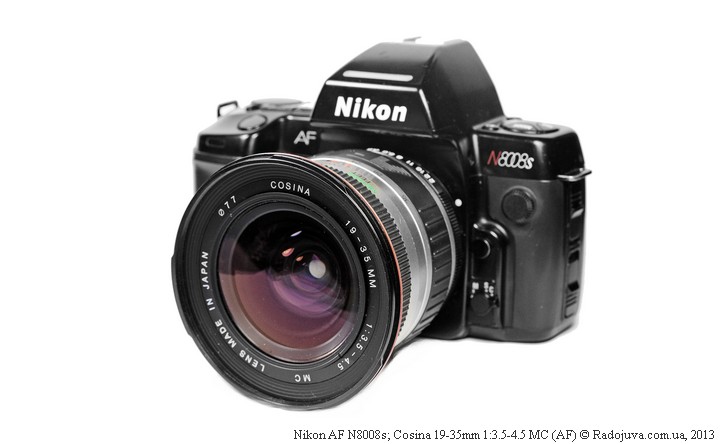
Actually, in this photo almost the whole essence of the article :)
Therefore, if there is a key aspect - desire, then for only 240 cu can:
Shoot with a full-frame SLR camera, with fast automatic focus, good serial shooting with a huge frame buffer, a huge optical viewfinder, nice controls and at the same time take pictures at 28 MP.
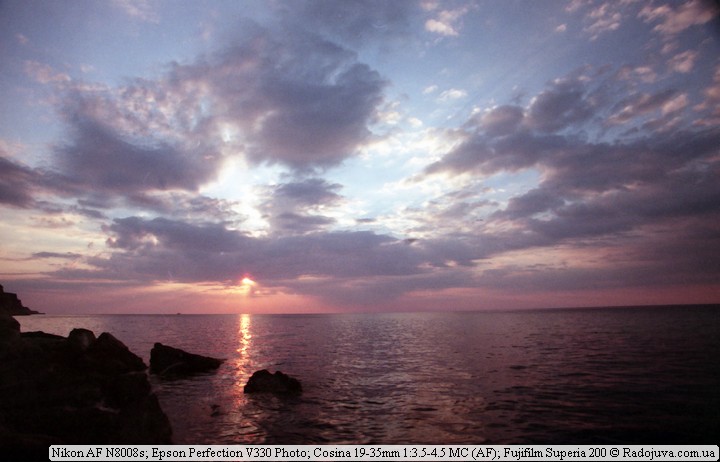
Example photo on my set. Sunset.
The secret is very simple - just use a film camera.
Many readers may think that the film camera is something terribly ancient, incomprehensible to manage, morally obsolete and unsuitable for use in the era of modern monsters Nikon D4 and Canon 1DX. In the expanses of the CIS countries such an impression people have it from the fact that in the Union and on its territory not a single SLR narrow-camera camera with automatic focus was released. Seriously, the old Zeniths do not cause any interest among young people, the main reason for which is the complete obsolescence of technology.
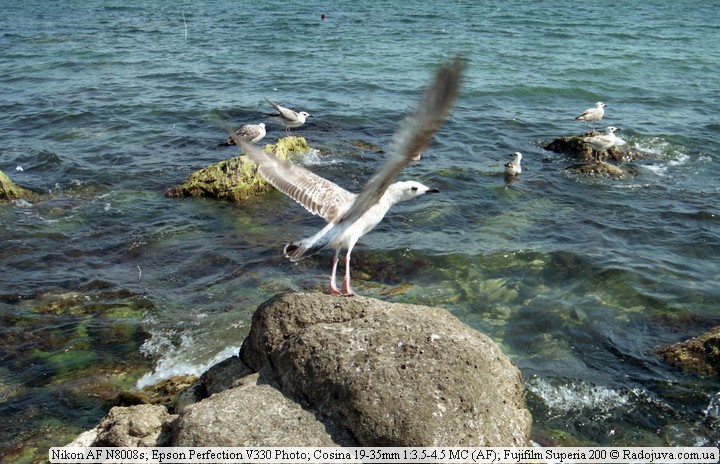
Example photo on my set. Gull
But in other countries long ago let out pretty autofocus analog volatile DSLRs with interchangeable lenses. Moreover, using such a SLR camera is no different from any modern amateur DSLR camera. Nikon D3200 or Canon 600D.
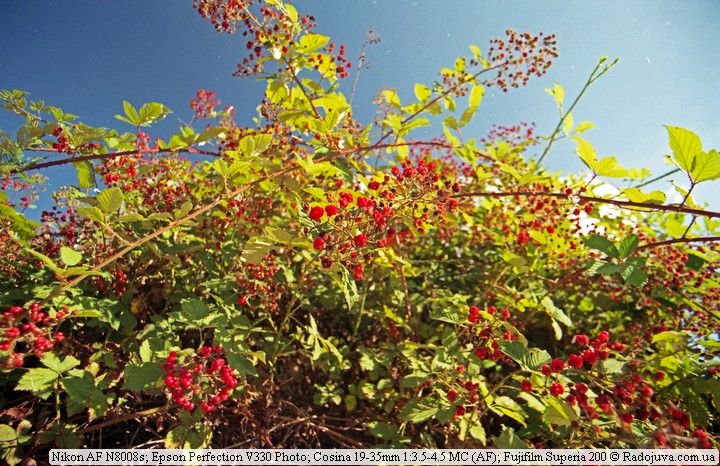
Example photo on my set. Forest Blackberry
I conducted an experiment, which cost me quite inexpensively, as a result of which this kit was assembled here:
- Nikon AF N8008s (also known as Nikon AF F801s) - 400 UAH
- Cosina MC 19-35mm 1: 3.5-4.5 (AF) - 700 UAH
- AA Batteries * 4 - 20 UAH
- 200-frame Fujifilm Superia 36 film roller - 27 UAH with free development
- Epson Perfection V330 Photo Scanner - 650 UAH
- Shipping of the camera, lens and scanner - 80 UAH
Total 1877 UAH or 235 cu In fact, I could save on the lens and batteries, since I have both. The camera, film roll and scanner cost me some 140 cu
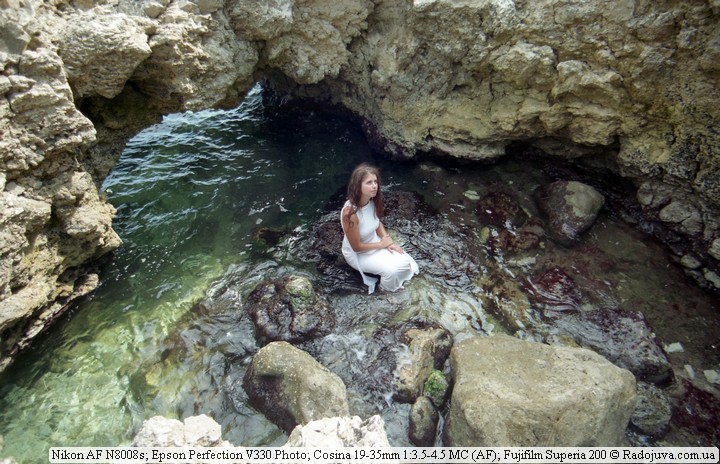
Example photo on my set. Among the stones
As a result, I got:
- A full-frame camera with a shooting speed of 3.3 frames per second. Some amateur cameras have approximately the same shooting speed. Nikon D80, D70s, D3000, D3100, and some professional CZK for 500 cu they shoot even slower, for example, Fujifilm Finepix S5 Pro.
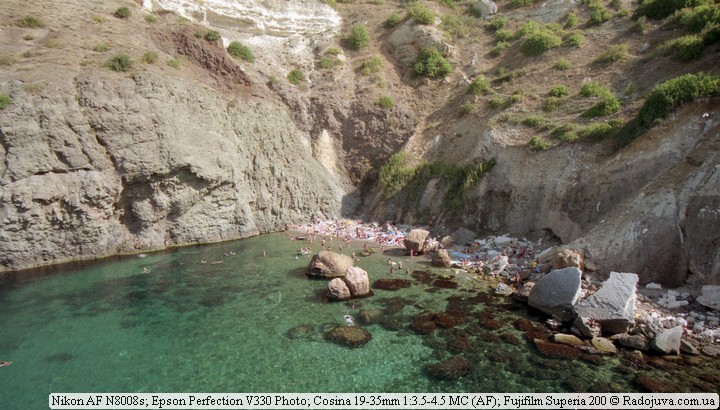
An example of a photo on a film camera. Beach.
- Maximum frame buffer makes 36 shots, for example, Nikon D7100 with the highest quality has frame buffer only 6 shots (RAW, 14-bit, lossless compression).
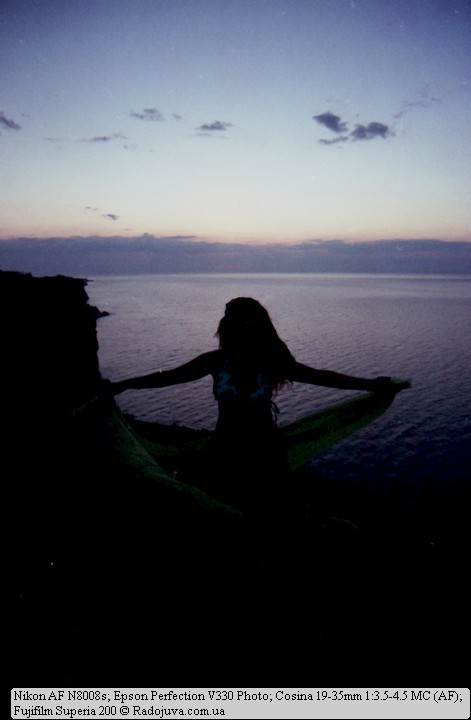
An example of a photo on a film camera. After sunset
- My camera can work out super short shutter speed equal to 1/8000 seconds, which even can not Nikon D600 и Canon 6D.
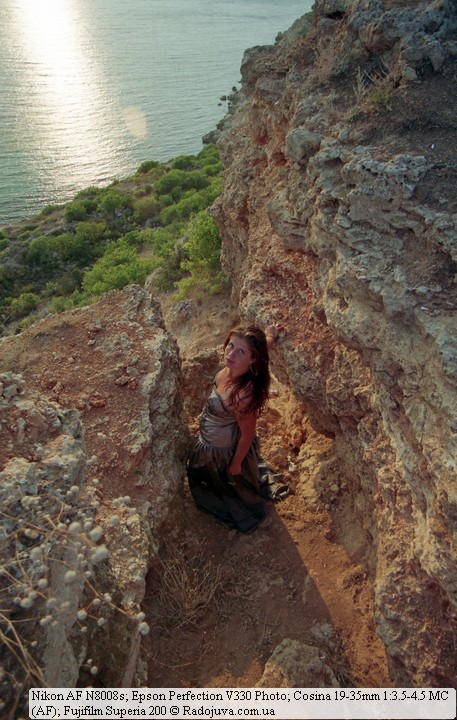
Example photo on my set. Among the stones
- A huge optical viewfinder that never dreamed Canon 70D for 1500 cu Yes, and in itself Nikon AF N8008s very good and durable camera.
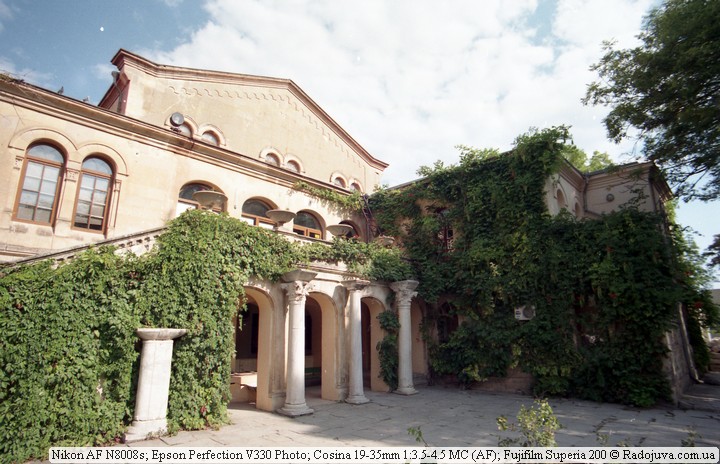
An example of a photo on a film camera. House overgrown with grapes.
- My Nikon AF N8008s it works easily with manual optics - it correctly measures exposure, has an electronic range finder, which very accurately tells about focusing. Even Nikon D5200 for 600 cu can't measure exposure with AI-S lenses.
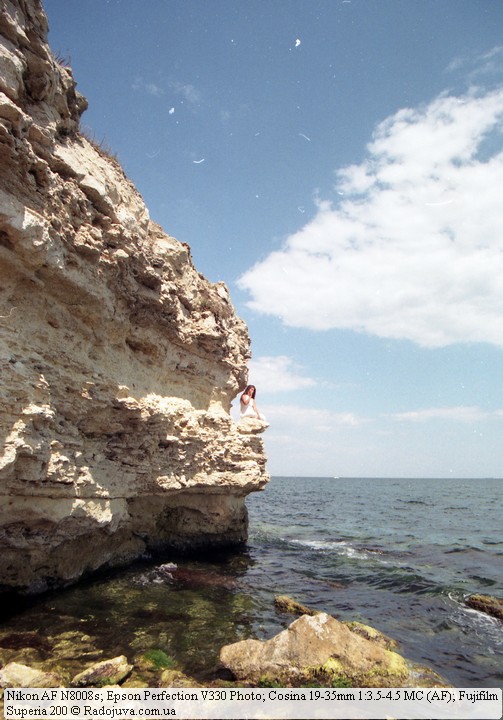
An example of a photo on a film camera. Sitting on the rocks.
- Very nice LCD in JVI, its brightness is physically (not electronically) dependent on the light source. The brighter the source - the brighter the LCD, which allows you to always clearly see the camera settings in JVI. For example, on many CZKs, I don’t see the LCD at all on a bright day or when shooting in backlight.
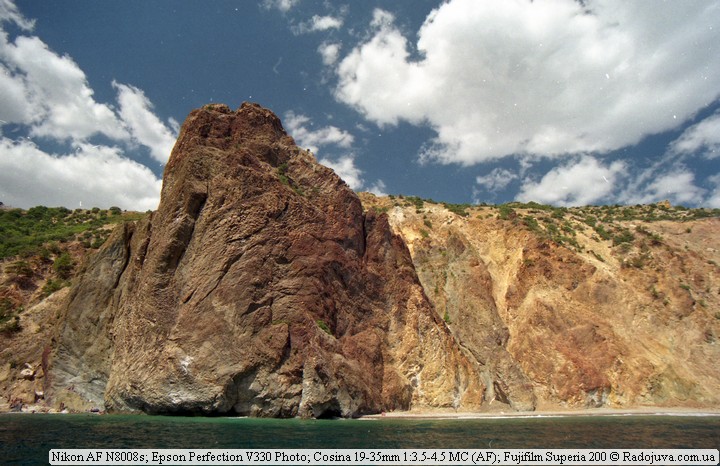
Example photo on my set. Photo from the boat
- Camera control is almost the same as that of any other Nikon CZK. When shooting, you don’t feel any difference, the whole setup is on a monochrome display.
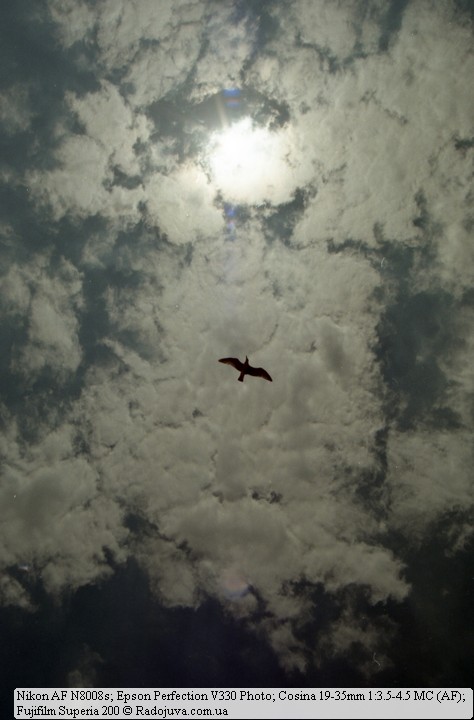
An example of a photo on a film camera. Gull
- Lens Cosina MC AF 19-35mm 1: 3.5-4.5 I just bought it for fun. 19mm at full frame can be safely attributed to an ultra-wide range of focal lengths. The lens focuses terribly fast, and with it you can create amazing pictures. To get the same viewing angle as this cheap lens gives out, on Nikon cropped cameras you should use the expensive Nikon 12-24mm F / 4.0.
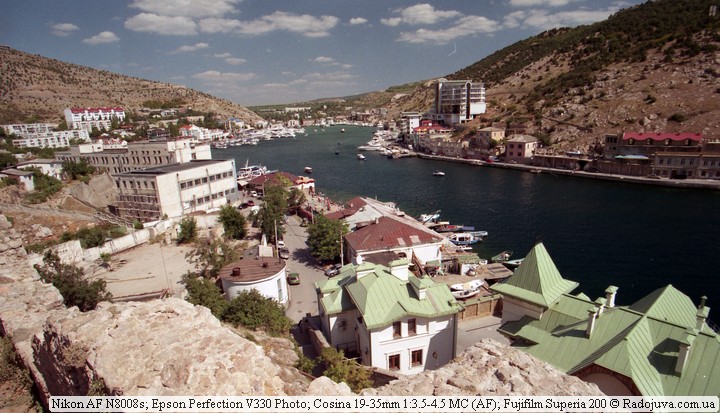
Example photo on a film camera
- A scanner in the house is also useful, for example, to digitize old photographs for an album. For example, you can scan your school diaries, and share old memories on social networks. In any case, the scanner will not be redundant.
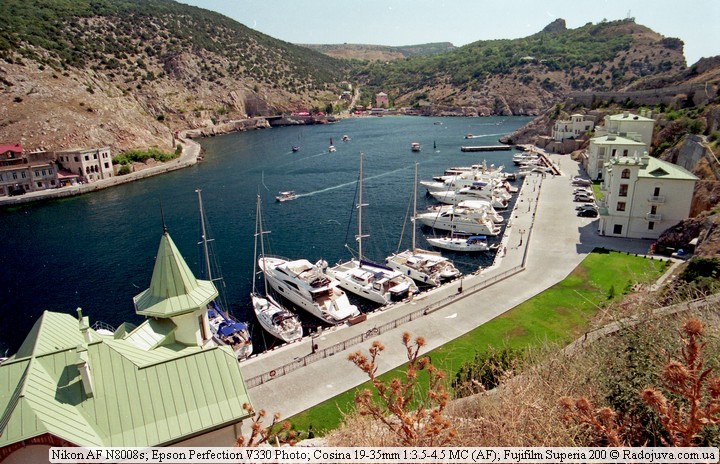
Example photo on my set. Yachts
- The scanner allows you to obtain images with 48-bit color depth. This means that each channel is encoded with 16 bits. Most 'cool modern cameras'can encode a channel using only 14 bits, and receive 42 bits at the output. Theoretically, with my scanner, you can get 64 times more shades than with any DCC.
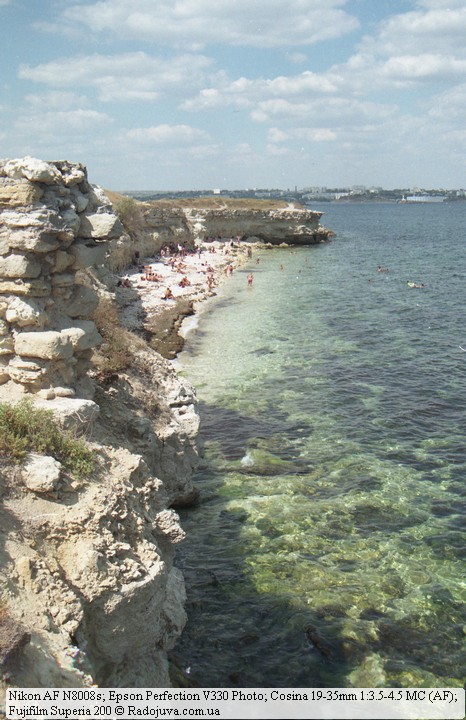
An example of a photo on a film camera. Shore
- Of course, my set has more disadvantages than advantages :), but I’ll keep silent about them in this article.
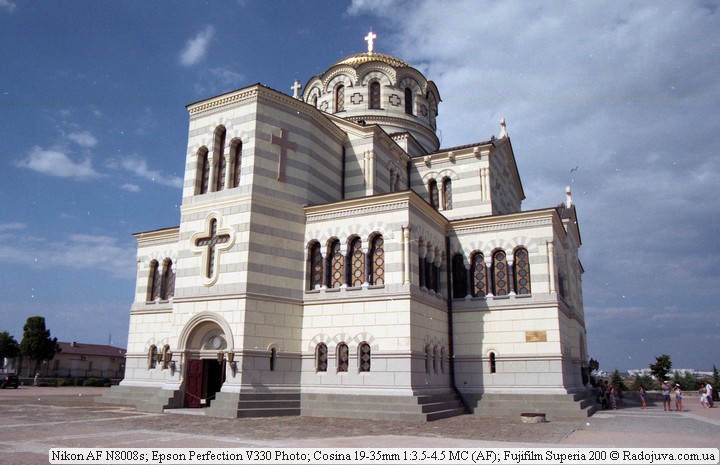
Example photo on my set. Temple in Chersonesos.
The following describes where I got 28 MP from the old film camera.
Of course, the 28MP figure in the article is a duck. But you can still get this figure in this way - the film has a physical frame size of 24mm * 36mm. Let's find the area of the film in square inches, since the parameters of the scanner are indicated in inches.
1 centimeter = 0.393700787 inches
1 square centimeter = 0.15500031000062 frame inches
1 square centimeter = 100 square millimeters
1 square millimeter = 0.0015500031000062 cpi
As a result, the film area is24mm * 36mm * 0.0015500031000062 = 1,339202678405357 sq. inch
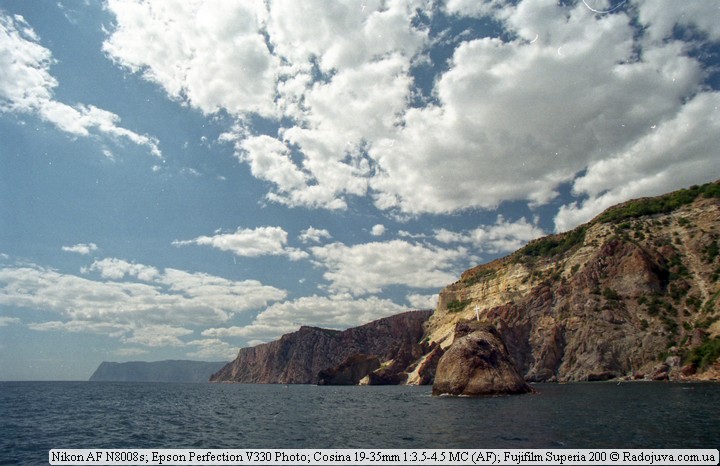
Example photo on my set. Landscape
The area of the film is 1,339202678405357 sq. inches. My scanner scans at 4800 pixels per inch, or 23 pixels per square inch. From 040 square inches of 000 pixels per square inch, 1,339202678405357 23 040 pixels are obtained, which is approximately equal to 000MP.
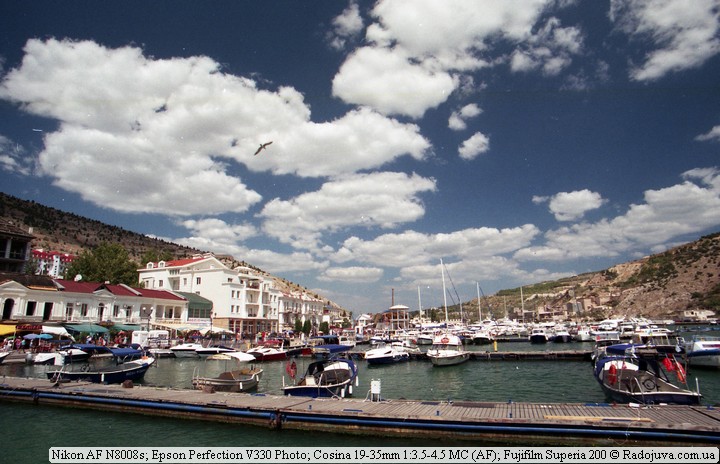
Example photo on my set. Balaclava
If your scanner has a different DPI, then the number of pixels when scanning a film frame can be calculated using the following simple formula:
DPI * DPI * 1,34
Some scanners in specifications have different DPI in height and width, for example, 4800 * 9600 is indicated in the specifications of my scanner. In fact, I can only scan at 4800 * 4800 or 9600 * 9600. The last option is half interpolation. The 'maximum possible DPI' is often indicated, for example 128000 is simply bloating the final image using a mathematical method of interpolating pixels, these numbers should not be paid attention to.
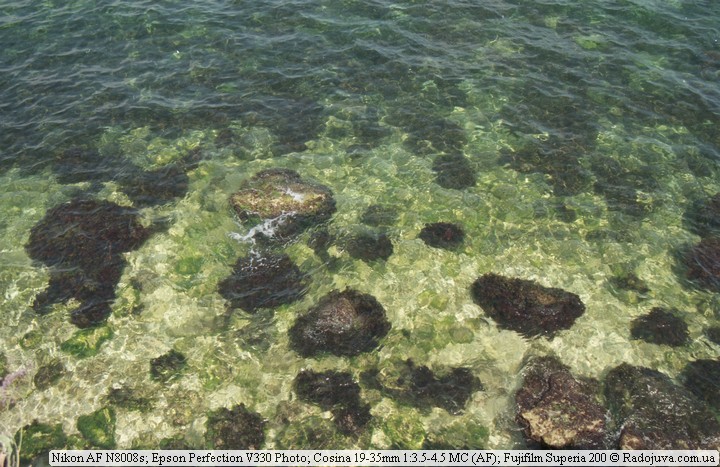
Example photo on my set. Near the shore
The simplest scanners with a slide adapter have 1200dpi, as a result, such a scanner can be squeezed out of one film shot:
1200 * 1200 * 1,34 = 1 929 600 (total about 2 MP)
I indicated '28MP camera' in the title of the article, since my Epson Perfection V330 Photo cuts off the edges of the frame a little when scanning and we end up with images not from the entire area of the film, but from a slightly smaller area. For example, a scanner often creates images like 6639 * 4319 pixels. Those who are chasing megapixels have already realized that from such a simple set you can squeeze these (or not these?) megapixels almost as much as Nikon D800 (a D800 costs almost 3000 cu).
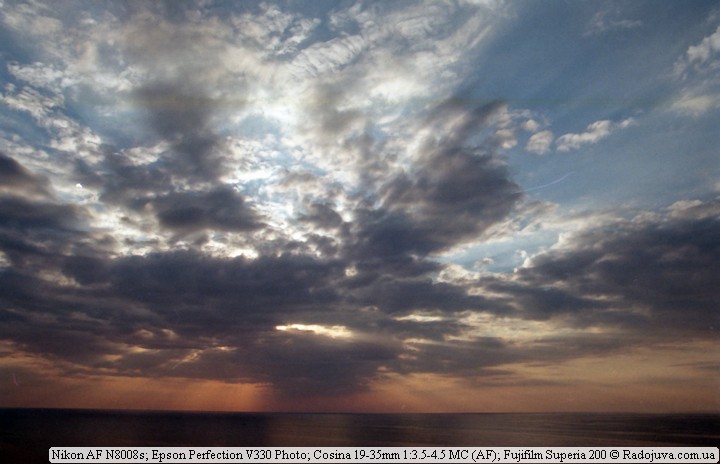
Example photo on my set. Another sunset
By itself, for serious work, such a set is no good. But the task before me was quite amateurish. For 240 cu I can enjoy a full-frame camera with convenient professional-grade control, an ultra-wide-angle lens that helped me out well on vacation and in addition I have a scanner that is convenient for scanning mail invoices :). I do not advocate fussing with a film camera, but once again I want to emphasize that there is absolutely no difficulty in working with a good analog camera. And instead of being discouraged that someone full frame, you can easily and simply shoot a full frame yourself.
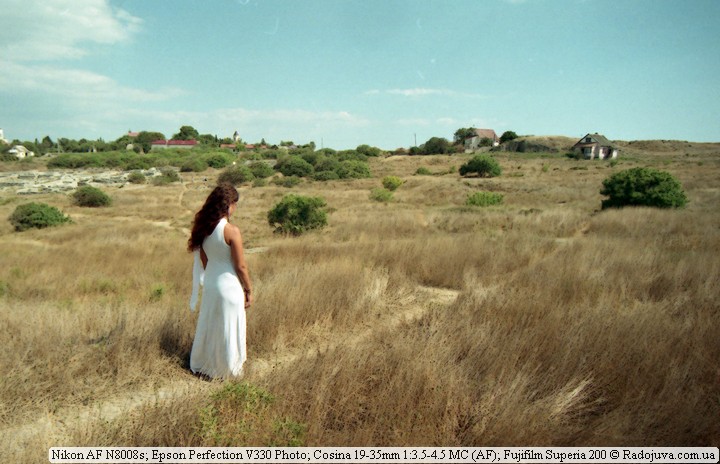
Example photo on my set. Road.
More sample photos (1400 pixels long)
Conclusions:
All of the above applies not only to my set. I brought my film set as real worldly example. Now buy used Nikon or Canon's autofocus analog camera is easy, the same goes for good-old lenses. The same story with the scanner.
Comments on this post do not require registration. Anyone can leave a comment. Many different photographic equipment can be found on AliExpress.
Material prepared Arkady Shapoval. Training/Consultations | Youtube | Facebook | Instagram | Twitter | Telegram















































V and to r u - The complete set is here: http://www.ebay.com/itm/Nikon-Super-Coolscan-LS-2000-35mm-Slide-Film-Scanner-XP-Win7-64-32-bit-/261345022676?_trksid=p4340.l2557&orig_cvip=true&rt=nc&nma=true&si=lGaTyd0MOvs2KPPZ0eP/e3hrI1w=&forcev4exp=true
Another comparison of the tablet (medium) with a slide module and a specialized one: http://www.ixbt.com/digimage/epson3200.shtml
Medium format tablet: http://image.ayalla.ru/download/mformat/008_planar_reala100_epson3200.jpg
Arkady Shapoval, All pictures are scanned by that simple scanner that you indicated?
Yes, because they even have a watermark indicating this scanner.
Please tell me, but on Epson Perfection V370 Photo, will it be worse to give out pictures? I don’t need much quality, such a photo as you took off with a book would be very fine for me. I have the same appatat and I love the film, but 30 hryvnia film and 35 (hryvnia frame) scanning, then 65 hryvnia for 35 frames is somehow a lot .
Arkady has exactly the same ... (Epson Perfection V370 Photo has a little more DD)
An interesting option for having an arsenal of retro optics http://kenrockwell.com/nikon/df.htm It is necessary to ask “Paparazzi” for sponsorship for the review….
Tell me, is the resource of film adapters on tablet budget scanners limited?
On very budgetary (passive ...) the lamp diffuser is the first to burn out (protect from long-term work with dense materials ...), on active (with a parallel displacement of the module lamp ...) - ten thousand scans with proper maintenance ... (when the grease thickens, it starts to strip ...). The most unpredictable resource for lamps that require warming up for calibration (better with LEDs, but they also have disadvantages ...).
Make a translation by Ken Rockwell (for calculating megapixel film ...) http://kenrockwell.com/tech/film-resolution.htm
Get Ken Rockwell's translation (Why We Love The Movie ...) http://kenrockwell.com/tech/why-we-love-film.htm
Nikon 4000 (http://vgrin.host56.com/photo/examples/n4000_v330/CP_005_0003.jpg)
Epson v330 photo (http://vgrin.host56.com/photo/examples/n4000_v330/CP_005_0003_v330.jpg)
Both images have 1000 dpi, epson and really do not reach them, despite the claimed 4800 x 9600 dpi optical resolution
Can the Sb-700 flash be connected to it?
I want to thank Radozhiva for her work. Thanks. You and your reviews helped me buy some good glasses, and your thoughts are often close to me. On the topic - when I realized that it would not work out quickly on canon 5D, I bought a canon 5 film on ebee. The price of the issue is $ 50, the pleasure of the film is a lot, and a full frame to boot. And “thoughts” to make pressure on the fact that with all the inconveniences of the film, there are more good shots from it. The 36-frame limitation makes you think before the "click". Plus the ability to "change" the matrix for a penny until you find your own, the most suitable one.
Comparison of the number, scanned slides and the same crops through a microscope (on the number ...) http://www.mindspring.com/~tony1964/MicroSlides.html The possibilities of the film are much higher than we extract them….
I decided to try my old Pentax PZ-6 autofocus with film before reading this article. Indeed, it is interesting to try full frame. Friends are dissuaded from this step. Say, you will be disappointed in the film. But I'll try anyway. Pentax does not yet have a full frame (figures), its lenses are decent - here, as they say, cards are in hand)) Yes, digitization is the bottleneck, it will cut the quality. But ... trying is not torture. Then I'll write down my feelings.
Who will shoot on a slide - take into account that even professionals (photographers, journalists, etc.), exhibiting the best film (Nikon and Canon) with their unsurpassed "exposure meters", did briquetting (plus or minus 0,3 stops) on especially valuable frames ... Even a small error leads to significant losses. The F-5 helped me out very well.
And the biggest loss can be obtained when developing slides…. For several years Viktor Lushnikov has been preparing a thermostat for serial production with an accuracy of hundredths of a degree ...
Good day! I read the article, and everything seems to be nothing, and even very interesting and tempting, BUT !!! I myself am the owner of Kiev-60 (who would not say anything, but in terms of reliability it is much better than any Pentaconov Six) and a park of lenses, among them MC Sonnar 180 / 2.8 (an excellent portrait lens, even on a crop it is such, though the distances grow at times) ) as an option a high-aperture telephoto lens), PCS Arsat 55 / 4.5 (probably the rarest lens that I have heard of, and unrealistic sharpness, 98/71 ops / mm), Flektogon 50/4, MC Wave 3B, and the Zodiac was also lying around , for entertainment)) And I am also the proud owner of an Epson V700 scanner, with a scanning resolution of 6400 × 9600 dpi. In theory, this scanner can squeeze 81 megapixels out of a small format, and 280 megapixels out of an average one !!! But here this BUT comes into play !!! In fact, it turns out that these dpi (hardware points) are almost impossible to convert to ppi (image points), in fact, you can only squeeze out 2100ppi, which is far from 9600, and from this it follows that ancient scanners with the ability to scan slides are not far behind the V700 monsters and V750, only the processing algorithms have improved, but I have the right hands, it is not difficult to fix it in Photoshop. Having learned about all this at first I was upset, but not for long, because it was decided to replace the system of mirrors in the scanner (due to which such desired ppi decreases, and in particular due to the diffraction effect) with reflective surfaces without glass, in order to return these same ppi, and squeeze the maximum out of it)) a scheme was thought out according to which all this would be done, as well as offices were found in which you can order the necessary surfaces for replacing mirrors, but then one fine I was impatient with the whole thing , in the sense of photographing on film, to translate into money, taking into account the long-term perspective, and then I was in for a SHOCK !!!
And so, what were my calculations: Canon 5D Mark III - a shutter life of 200 actuations, the price was about 000-70 thousand rises. rubles. Everything is clear here. And then I calculated the cost of film for the same number of exposed frames in medium format when using slide film, everything was very approximate, so: a roll of film, when ordering from New York, about $ 90. the cost of developing one video for E-10 6 USD for 6 exposures, using a 200x000 frame requires 6 film rolls !!! not to mention the 4.5x16000 frame)) Total: the cost of the film alone will be 6 USD. !!!!! A-A-A-A-A-A !!!!! After this figure, my hair stood on end)))) And this is without development))) So, development: in St. Petersburg, the cost of developing one roll of film on E-9 is about 160-000 USD. now we count 6 * 6 = 7 USD !!!!! A-A-A-A-A !!!! After these numbers, my hair turned gray))))) Even if we consider that you are a super specialist and show the slide yourself, then only the cost of the film itself is not that impressive, but simply shocks)) after such calculations, it was decided to buy a Canon 16000D Mark III (fortunately, the cost of all lenses was enough for him))) and a fleet of good old manual lenses such as Helios-6, Helios-96000, Meyer Trioplan 5 / 40, MC Jupiter-44A, and other excellent lenses for small format) ) you ask why buy a Mark III and put old stuff on it ??? I will answer that the Mark III suits me with its characteristics, and the old manual lenses are just their imperfection and their beautiful, unlike anything else, of course, you will have to buy a couple of autofocus lenses, but the basis is only good old lenses made of metal and glass))
I hope this "fairy tale" could be useful to at least someone))
I have been suffering from “photo fanaticism” for more than fifty years and have already compared everything (the second penny from Canon - from the very first series ... also in work), when high quality of the landscape is required - this is a film camera (6x9 or 6x7 “Mamiya”) or Nikon F- 5, when responsiveness is CANON 5D mark II, when color priority is slide (Nikon F-5) or Fujifilm S3 pro, studio work is Nikon D1x, wedding photography is Nikon F-5. In a very distant reserve “Kiev and 60 and 88” with their not very sharp parameters (albeit with the rulers from “Petacon and Hasselblad” ... If you expect very high results - the cash costs are ... Well, and expecting 200 from the third Canon penny is not serious ...
The first Nikon F-5 passed more than 400000, and the price of the current $ 227 ... I think that even up to the comparable cost of CANON 5D mark III I have a lot of quite recoupable frames ... And the CANON 5D mark II resource often flies away to the basket ...
If you take into account the exactingness of the slide for storage, and the fact that you don’t really go with civilization on long trips far from civilization, and the cost of a good scanner, it still turns out that the figure is better for an amateur who does not take commercial shots, in my opinion it cannot be otherwise
Denis All my comments are for those striving to become at least a good “photo fan” ... As for storing slides - in a plastic frame, a vacuum bag with a hygroscopic bag (in the refrigerator) - your life will be enough for the initial scanning and further archival storage (if not killed processing ...) The cost of two specialized slide scanners is comparable to the price of your tablet (this requires patience, experience and a certain skill in EBAY (СanoScan 4000US, Polaroid Sprintscan 45 and Nikon Coolscan V ED - three, for the cost of your ...) And more, if very to put it mildly: “I really dislike CMOS - this is for: either those who have a lot of extra time, or for those who receive special satisfaction from the processing process (without a guaranteed result ...), or for those who have congenital problems with color perception (ready to issue color“ inconsistencies ”in one ordering ...). To the question “Is it possible cheaper ...? -“ It is possible, but please take into account - either good, or cheap ...
flueg, they littered the whole topic and never threw a link to their SHIDEVERS
On the account of “either good, or good, or good ...” I completely agree, but unfortunately few people will be able to tell the difference between “not bad” and “excellent”, now a lot of people consider the aiphon the best camera invented by a person)) a even more so if you take a nokia with a 40MP camera, it's just a fairy tale that they have your full-size ones with a 20-megapixel sensor, if he has 40 of them in his phone))))) all the same becomes art only when it other people can appreciate, and since there are not so many such people, and there are a lot of inconveniences with the film compared to the figure, then you can compromise)) of course this is a compromise to yourself, but what can you do)) but it is released a lot of free time and it becomes a little less headache)) and since for me photography is still a hobby, albeit a very serious one, but the rest also takes time))